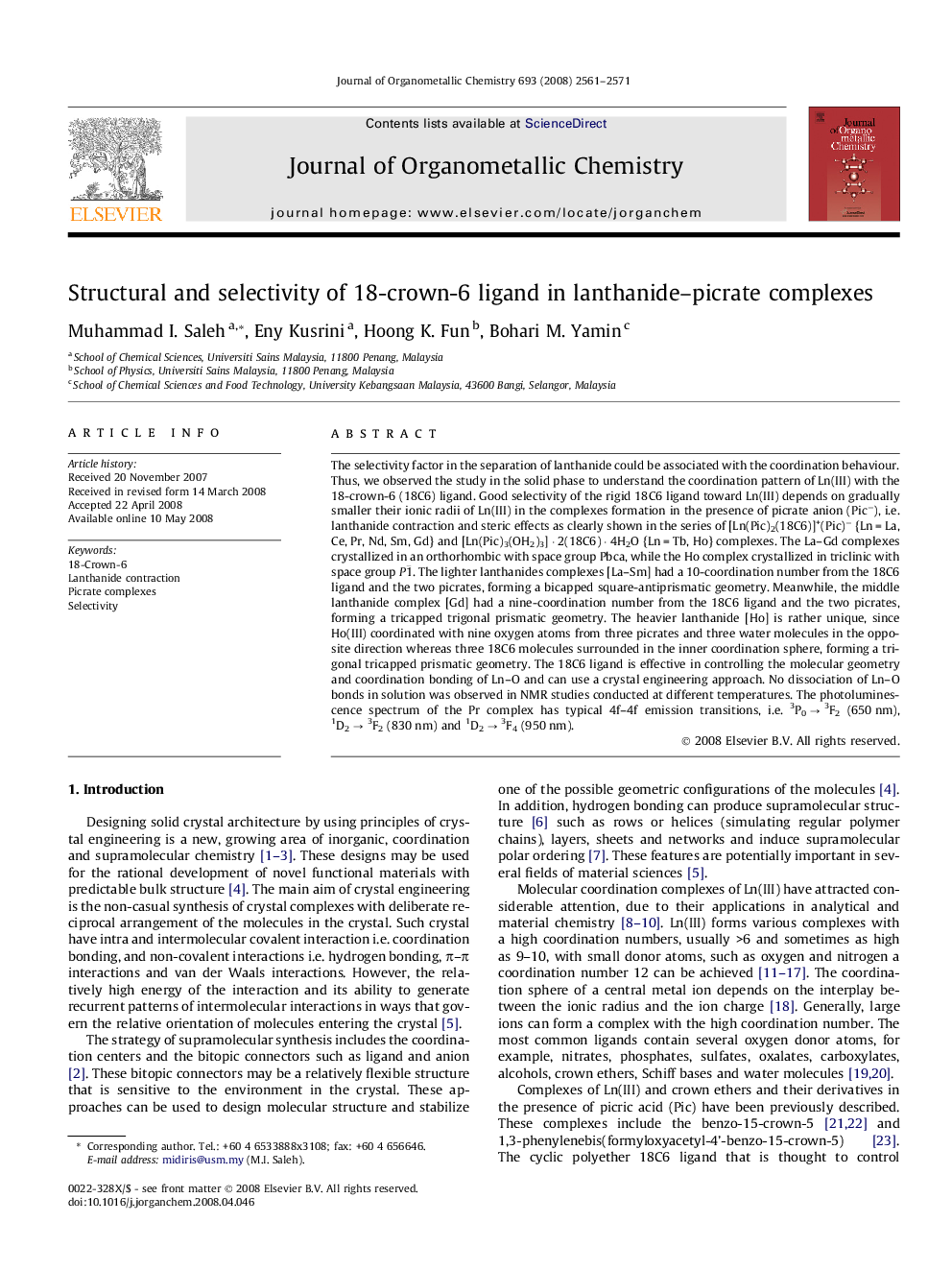| Article ID | Journal | Published Year | Pages | File Type |
|---|---|---|---|---|
| 1327956 | Journal of Organometallic Chemistry | 2008 | 11 Pages |
The selectivity factor in the separation of lanthanide could be associated with the coordination behaviour. Thus, we observed the study in the solid phase to understand the coordination pattern of Ln(III) with the 18-crown-6 (18C6) ligand. Good selectivity of the rigid 18C6 ligand toward Ln(III) depends on gradually smaller their ionic radii of Ln(III) in the complexes formation in the presence of picrate anion (Pic−), i.e. lanthanide contraction and steric effects as clearly shown in the series of [Ln(Pic)2(18C6)]+(Pic)− {Ln = La, Ce, Pr, Nd, Sm, Gd} and [Ln(Pic)3(OH2)3] · 2(18C6) · 4H2O {Ln = Tb, Ho} complexes. The La–Gd complexes crystallized in an orthorhombic with space group Pbca, while the Ho complex crystallized in triclinic with space group P1¯. The lighter lanthanides complexes [La–Sm] had a 10-coordination number from the 18C6 ligand and the two picrates, forming a bicapped square-antiprismatic geometry. Meanwhile, the middle lanthanide complex [Gd] had a nine-coordination number from the 18C6 ligand and the two picrates, forming a tricapped trigonal prismatic geometry. The heavier lanthanide [Ho] is rather unique, since Ho(III) coordinated with nine oxygen atoms from three picrates and three water molecules in the opposite direction whereas three 18C6 molecules surrounded in the inner coordination sphere, forming a trigonal tricapped prismatic geometry. The 18C6 ligand is effective in controlling the molecular geometry and coordination bonding of Ln–O and can use a crystal engineering approach. No dissociation of Ln–O bonds in solution was observed in NMR studies conducted at different temperatures. The photoluminescence spectrum of the Pr complex has typical 4f–4f emission transitions, i.e. 3P0 → 3F2 (650 nm), 1D2 → 3F2 (830 nm) and 1D2 → 3F4 (950 nm).
Graphical abstractThe mononuclear [Ln(Pic)2(18C6)]+(Pic)−{Ln = La–Gd} and [Ln(Pic)3(OH2)3] · 2(18C6) · 4H2O {Ln = Tb, Ho} complexes have been synthesized and characterized by reaction of [Ln(Pic)2(OH2)6]+(Pic)− · 6H2O with the 18C6 ligand in a 1:5 ratio. The current study was evaluated in the solid phase to understand the coordination pattern of Ln(III) with the 18C6 ligand. The small differences in the ionic radii of Ln(III) play an important role in the selection of electron rich atoms for the formation of coordination bond. The X-ray crystallographic analysis for the La–Gd complexes indicated the existence of interaction between the Ln(III) ion and the oxygen atoms of the 18C6 ligand in the crystalline state. The 1H NMR spectra suggested no interaction between the Ln(III) ion and the 18C6 ligand in the solid state and/or solution was observed for the Tb and Ho complexes. Good selectivity of the 18C6 ligand toward Ln(III) in the presence of picrate anion (Pic−) which depends on the lanthanide contraction and steric effects were observed.Figure optionsDownload full-size imageDownload as PowerPoint slide
